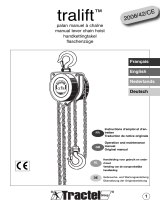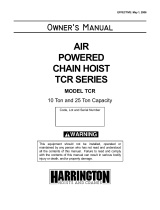
8 Form 47584686001 Edition 5
EN
INSTALLATION
Prior to installing the hoist, carefully inspect components for possible shipping damage.
Hoists are supplied fully lubricated from the factory. Refer to “Lubrication,” section for
recommended oils and lubrication intervals. Lubrication
of the load chain is recommended
before initial hoist operation.
WARNING
● A falling load can cause injury or death. Before installing, read Product Safety
Information Manual.
● Owners and users are advised to examine specic, local or other regulations, including
American National Standards Institute and/or OSHA Regulations which may apply to a
particular type of use of this product before installing or putting hoist to use.
● The strength of the hoist, chain and hooks can be aected by chemically active environments,
such as caustic or acid substance fumes. A qualied person should be consulted before
hoists are used in chemically active environments.
Mounting
Always make certain the supporting member from which the hoist is suspended is strong
enough to support the weight of the hoist plus the weight of the maximum rated load plus a
safety factor (consult a structural engineer).
If the hoist is suspended by a top hook, the supporting member should rest completely within
the saddle of the hook and be centered directly above the hook shank. Do not use a supporting
member that tilts the hoist.
Hook Mounted Hoist
Place hook over mounting structure. Make sure hook latch is engaged.
Trolley Mounted Hoist
When installing a trolley on a beam, measure beam ange and temporarily install trolley on
hoist to determine the exact distribution and arrangement of the spacers. Adjust spacers in
accordance with trolley manufacturer’s literature to provide the correct distance between the
wheel ange and the beam. The number of spacers between the trolley side plate and mounting
lug on hoist must be the same in all four locations in order to keep the hoist centered under the
I-beam. The remaining spacers must be equally distributed on the outside of the side plates.
WARNING
At least one mounting spacer must be used between the head of each trolley bracket bolt
and the trolley bracket and between each trolley bolt nut and the trolley bracket. Failure to
do this could cause the hoist to fall when used improperly.
Make sure trolley bolts or nuts are torqued in accordance with manufacturer’s specications.
For installation of hoist and trolley on beam, make certain the side plates are parallel and vertical.
After installation make sure beam stops are in place, operate trolley over entire length of beam
with a capacity load suspended 4 to 6 inches (10 to 15 cm) o the oor.

























